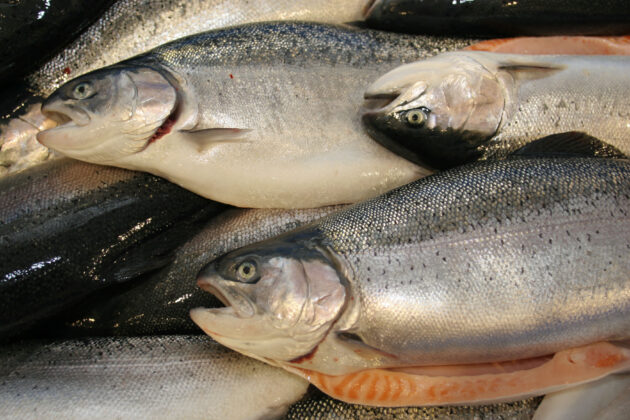Aquatic food systems
Aquatic food systems in the Nordic countries

In this project, we will map out the challenges and opportunities for increasing the consumption of aquatic food in the Nordic region. We will also examine the role of aquatic food systems in relation to food security, and map greenhouse gas emissions in different parts of the value chains in these food systems.
Start
01. Dec 2024
End
31. Jan 2026
Funded by
The Nordic Council of Ministers
Cooperation
Norway: Nofima, Sweden: Lund University, Denmark: University of Copenhagen, Aarhus University and University of Southern Denmark SDU, Iceland: University of Iceland, Finland: LUKE, The Faroe Islands: University of the Faroe Islands
Project Manager(s):
Other Participants:
Background
Aquatic food systems play an important role in the global food system. They contribute significantly to food security, nutrition, and economic development.
Aquatic food has a lower climate impact than many other foods and constitutes an important part of a healthy diet. At the same time, the consumption of aquatic food in the Nordic region is below the level recommended in the Nordic Nutrition Recommendations (NNR2023). These recommendations highlight both the nutritional value of aquatic food and its lower climate impact compared to other foods. It is therefore important to investigate how the consumption of aquatic food can be increased in a sustainable way.
The Nordic countries manage large sea and ocean areas that are some of the most productive in the world. Additionally, several of the species living in these ecosystems are important sources of human food. Large parts of the near-coastal areas are also very well suited for marine farming of salmon and trout.
Through this project, we will further develop knowledge on how aquatic food can contribute to ensuring a sustainably increased intake of sustainable and healthy food in accordance with the Nordic Nutrition Recommendations. In addition, knowledge about greenhouse gas emissions in the production of aquatic food will be significant in the work towards the green transition and sustainable resource utilisation.
Although the Nordic region has significant aquatic food production, the focus is often on land-based food when food security and preparedness are discussed. This project will therefore also map the role of aquatic food systems for food security and preparedness in the Nordic region.
Objectives
In this project, the objectives are:
- To map out the challenges and opportunities for increasing the consumption of aquatic food.
This part of the project will analyse what influences the consumption of aquatic food in the Nordic region and assess the potential for increased consumption in various regions, in line with the Nordic Nutrition Recommendations. Furthermore, we will review EU initiatives aimed at helping consumers make healthier and more sustainable food choices. The project will follow up on the report “Policy tools for sustainable and healthy eating” and investigate specific advice that can be given to increase the consumption of aquatic food based on this. The results will include recommendations on how consumption can be shifted towards aquatic food from sustainable stocks, as well as exploring the possibilities for a more diversified consumption of less established species. The project will also map out the measures Nordic authorities have implemented to follow up on the Nordic Nutrition Recommendations, with a focus on aquatic food. The knowledge will primarily be based on available literature, and the collaborating institutions’ knowledge of local conditions will be important. - To map out the role of aquatic food systems for food security.
This part of the project will analyse the flow of goods and access to aquatic food within the Nordic region, including dependencies on regions outside the Nordic area. Here, we will also map out the location and role of the processing industry in the food system. This part of the project will be based on public data sources on production, catch, trade, and consumption, as well as relevant literature. The results will clarify the role of aquatic food for food security and preparedness in the Nordic region. - To identify greenhouse gas emissions in Nordic aquatic food production.
We will identify greenhouse gas emissions and the main drivers behind these, and estimate the size of such emissions in Nordic aqatic food production. We will link emissions to individual products in broad categories, for comparisons with other food products and to find differences between nations. We will also point out the main categories of waste in the value chains for the production of aquatic food, and highlight the effects of waste for industry players and society as a whole.
The study will focus on the Nordic countries (Denmark, Finland, Faroe Islands, Greenland, Norway, Iceland, Sweden) and provide recommendations that can be implemented in these countries to sustainably increase the intake of aquatic food. There are significant differences in both value chains and fish consumption in the Nordic countries, which the study will take into account and provide specific recommendations per country where differences are significant.
Nordic cooperation
The project will build on existing data and knowledge from a range of projects at Nofima and the collaborating institutes. In this regard, analyses from Iceland, Denmark, the Faroe Islands, Greenland, Sweden, Finland and Norway will be compiled to describe the aquatic food systems along the following dimensions:
- How the systems are organised and located
- How the food systems are regulated
- Product portfolio
- Flow of goods (volume and value) to various countries
- Which countries the end products are consumed in
- Barriers and opportunities for increased consumption of aquatic food
- The climate impact of food production through greenhouse gas emissions in the value chains
Here, we will emphasise whether different parts of the food systems, and consumption, take place within or outside the Nordic region.
This is a Nordic collaborative project with researchers from Norway, Sweden, Denmark, Finland, The Faroe Islands and Iceland. The researchers have extensive experience in research on aquatic food systems and consumer behavior related to aquatic food.

